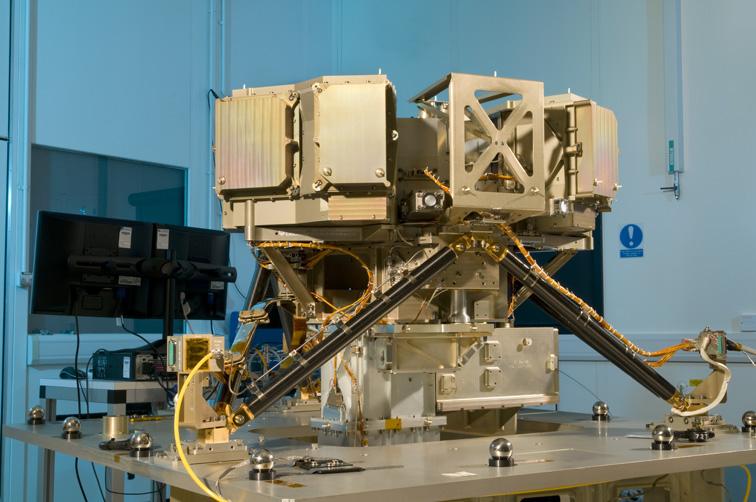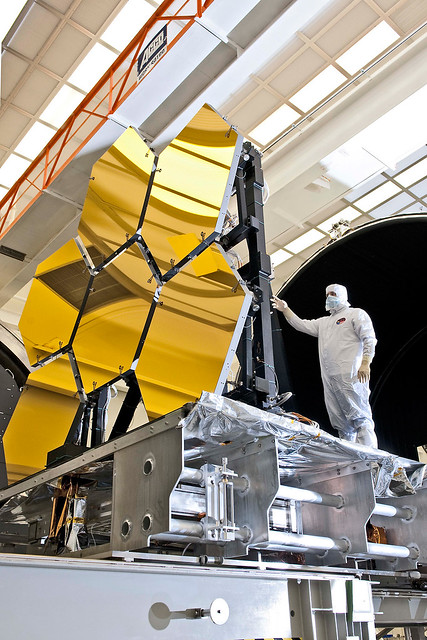At a time when America could certainly use something to be proud of, we are at risk of terminating our grandest shot at it – The James Webb Space Telescope. The engineering and scientific gains that have and will come from Webb are unprecedented. Most recently, the telescope reached its most significant milestone to date. All primary mirror segments successfully completed manufacturing. Yet the program has been put on the chopping block. The U.S. House of Representatives Appropriations Committee recently voted to terminate funding, and by doing so, end America’s long history of leadership in space science and technology.
Finishing Webb’s mirrors is much more than a remarkable technological achievement. It puts most of the Webb telescope’s developmental risk and uncertainty behind us. What remains is assembly of the completed components and integration and testing as we continue to move to the launch date. With nearly 75% of the mass of the telescope in production or complete, we have demonstrated that we can do it.
NASA has invested $3.5 billion to build the Webb telescope, an investment in the greatest technological breakthroughs of our time. Ten innovative and powerful new technologies ranging from optics to infrared instruments to temperature control systems were developed, technologies that have already been spun off to help advance other scientific, medical and commercial endeavors.
For example, the advanced wavefront sensing developed for testing the Webb telescope’s 18 primary mirror segments led to a number of improvements in measurement technology used for human eyes, including ocular disease diagnosis and potentially improved surgery. Ophthalmologists routinely use wavefront technology to measure aberrations of the eye. Those measurements help with diagnosis, research, characterization and planning treatment of eye health issues.
According to Dr. Dan Neal, Research Fellow at Abbott Medical Optics Inc. in Albuquerque, N.M., wavefront technology also provides more accurate eye measurements for people about to undergo laser refractive surgery. As technology improves, so does the quality of these procedures.
A new “scanning and stitching” technology developed for the Webb telescope led to a number of innovative instrument concepts for more accurate measurement for contact lenses and intra-ocular lenses. This technique can help “map” the topography of the eye more accurately.
Four patents have been issued as result of innovations driven by the Webb telescope program. These tools are now used to align and build the next generation of measuring devices for human eyes.
The Webb telescope is also paving the way for future commercial and government technology applications. Industry relies on government to fund cutting-edge programs that often lead to spin-offs in many adjacent fields. An example is MRI technology improvements for cancer imaging that came out of the Hubble Space Telescope development.
In addition, projects like Webb are essential to maintaining the nation’s critical hi-tech skills and recruiting top talent to the aerospace industry, where the pipeline is facing a critical shortage as the generation inspired by NASA’s quest for the moon retires.
Inventing these technologies has truly been a team effort of NASA, Northrop Grumman, our principal subcontractors and many other team members large and small. Let’s take the example of the flight mirrors, polished by the amazing people at L-3 Tinsley in Richmond, Calif., led by our subcontractor Ball Aerospace. They personify the kind of ingenuity that put America at the forefront of daunting technological undertakings such as this.
In September, 2003, when Tinsley chose beryllium as the material that would comprise the mirrors, many people doubted that this lightweight material was even feasible for this purpose. And even if it was technologically feasible, the doubters predicted Tinsley would take “forever” to complete the task.
Tinsley proved the doubters wrong. They built a state of the art mirror polishing facility, including custom Computer Controlled Optical Surfacing system machines, temperature cycling ovens, and optical metrology. The level of precision they were able to achieve required an ability to polish away mere atoms at a time.
Imagine if the continental United States was to be polished smooth to the same tolerances. This continent – from Maine to California – would not vary in thickness by more than an inch. Tinsley’s work is virtually perfect.
We are also moving forward with a more advanced level of testing on the sunshield, the five- layer structure the size of a tennis court that will keep the telescope’s mirrors cold. Our partner Nexolve in Huntsville, Ala., will soon begin testing on the full-size layers to prove that the ultra-thin sunshield material will behave as we predict. Next, we’ll begin testing on the carefully orchestrated sequence the sunshield will follow as it unfolds after launch. Like L-3 Tinsley, Nexolve is a small company whose considerable technical skills are playing a significant role in building and testing the telescope. Dozens of small businesses like them all across the country have joined the Webb telescope team.
Tinsley’s accomplishment represents a decade-long team effort, not simply among scientists and engineers, but a team effort between the scientific community and all those who recognize what the James Webb Space Telescope means for our understanding of our universe; what it means for American innovation and technology; and what it means for the kind of technical leadership which so many of our nation’s leaders have said is so important to our national future and global competitiveness.
The Webb telescope program is critical to the national and international scientific communities. The National Academy of Sciences ranked it the highest-priority astronomy research project to be started in the last decade. And as one researcher and educator has observed, we are rapidly approaching the limit of what can be done scientifically without the James Webb Space Telescope.
There is something uniquely human – and certainly American – about exploration and the quest to learn where we came from and whether or not we are alone in this vast universe. The Hubble revolutionized our understanding of these questions. But the James Webb – and only the James Webb – will properly continue that exploration and understanding.
These are difficult and challenging economic times, but any short-term budgetary gains from canceling Webb would be more than offset by the loss of high-tech jobs, damage to U.S. leadership in science and technology, and loss of a mission that, like Hubble, is guaranteed to inspire the public and motivate large numbers of American schoolchildren to pursue careers in science, technology, engineering, and mathematics. Careers that will most likely not exist, if we as a country, cannot commit to pursuing technological advancements like those being made today on the Webb telescope.
I see Webb’s power of inspiration in my two young daughters, whose faces light up with excitement, curiosity and enthusiasm when I tell them about our work on the telescope. They and many other schoolchildren like them are this country’s future engineers and scientists. What are we as a nation telling them when our elected representatives vote to cancel the world’s most powerful space telescope? Are we saying our children’s aspirations and dreams have no future? And if that is true, what does that portend for the future of our nation? The James Webb Space Telescope has the power to move human knowledge forward in ways we can only imagine. Let us not abandon this quest now. Let us find a way to stay the course, for ourselves, our children and our children’s children.
You can show your support for the Webb telescope and America’s leadership in science and technology by visiting
http://www.northropgrumman.com/supportjwst/ 





